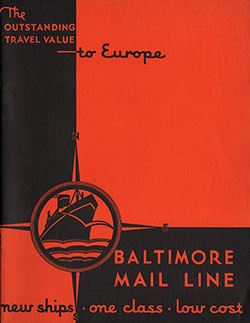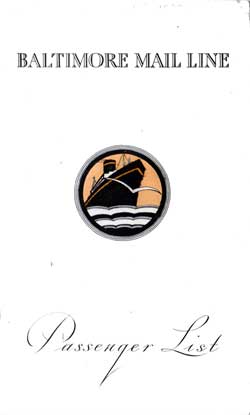Baltimore Mail Line: The Forgotten One-Class Transatlantic Steamship Service (1930-1937)
The Baltimore Mail Line (Baltimore Mail Steamship Company) was primarily a mail service that also carried a limited number of passengers (passenger capacity was about 80 Tourist Class). They operated regular weekly service between the US Ports of Baltimore and Norfolk to the European Ports of Le Havre, France, and Hamburg, Germany.
Their Fleet of Five ships, all built in 1918 as freighters of the Eclipse Class were rebuilt into 83-passenger / cargo combination transatlantic ships for the newly-formed Baltimore Mail Line. The Fleet, capable of a speed of 16 knots, consisted of the City of Baltimore, City of Norfolk, City of Havre, City of Hamburg and City of Newport News. The single class liners offered staterooms with outside exposure, hot running water, and Simmons beds.
In 1935, the Baltimore Mail Line offered fares to London or Hamburg for $90 one way or $171 round trip.
They were in operation for a relatively short time from 1930 to 1937. The assets of the Baltimore Mail Line were transferred to the Panama Pacific Line in 1938.
Baltimore Mail Line Ephemera in Date Order

1930s Brochure - Baltimore Mail Line Outstanding Travel Value
1930s Brochure offers extraordinary interior and exterior views (including passengers) of their transatlantic steamships of the Baltimore Mail Line with routes between Baltimore, Norfolk, Havre and Hamburg.

1932-01-29 SS City of Hamburg Passenger List
- Class of Passengers: Cabin (One Class)
- Date of Departure: 29 January 1932
- Route: Hamburg to Norfolk and Baltimore via Le Havre
- Commander: Captain John F. Jensen

1932 Brochure - Baltimore Mail Line Passenger Information
Rare Passenger Booklet from Baltimore Mail Line covers everything that their patrons would need to know about their voyage. Unlike many of the passenger steamship lines, the Baltimore Mail Line printed the Information for Passengers separate from the Passenger Lists.

1932-06-24 SS City Of Hamburg Passenger List
- Class of Passengers: Cabin (One Class)
- Date of Departure: 24 June 1932
- Route: Hamburg and Le Havre to Norfolk and Baltimore
- Commander: Captain John F. Jensen

1934-03-17 SS City of Hamburg Passenger List
- Class of Passengers: Cabin (One Class)
- Date of Departure: 17 March 1934
- Route: Hamburg and Le Havre to Norfolk and Baltimore
- Commander: Joseph Epps Lee, Lt. Cmdr., U.S.N.R.

1934-11-24 SS City of Hamburg Passenger List
- Class of Passengers: Cabin (One Class)
- Date of Departure: 24 November 1934
- Route: Bremen to Norfolk and Baltimore via Le Havre
- Commander: Captain Joseph E. Lee

1935-01-12 SS City Of Newport News Passenger List
- Class of Passengers: Cabin (One Class)
- Date of Departure: 12 January 1935
- Route: Hamburg and Le Havre to Norfolk and Baltimore
- Commander: Captain Robert H. Wright

1936 Brochure - Baltimore Mail Line to Europe
Baltimore Mail Line utilizes one-class liners. You can go anywhere onboard without worrying about class restrictions. Decks, lounges, dining saloon— there is no class distinction. Passenger accommodations throughout are of a single high standard.

1936-07-11 SS City of Norfolk Passenger List
- Class of Passengers: Cabin (One Class)
- Date of Departure: 11 July 1936
- Route: Hamburg and Southampton to Norfolk and Baltimore
- Commander: Captain Reginald Rose, Lt. Cmdr., U.S.N.R

1937-07-24 SS City Of Baltimore Passenger List
- Class of Passengers: Cabin (One Class)
- Date of Departure: 24 July 1937
- Route: Hamburg and Southampton to Norfolk and Baltimore
- Commander: Captain F. E. Cross, Lt. Cmdr., U.S.N.R

1937-08-15 SS City of Norfolk Passenger List
- Class of Passengers: Cabin (One Class)
- Date of Departure: 15 August 1937
- Route: Bremen to Norfolk and Baltimore via Le Havre
- Commander: Captain Reginald Rose, Lt. Cmdr. USNR

1938-04-11 SS City of Newport News Passenger List
- Class of Passengers: Cabin (One Class)
- Date of Departure: 11 April 1938
- Route: Bremen to Norfolk and Baltimore via Southampton
- Commander: Captain Robert H. Wright, Lt. Cmdr., U.S.N.R
- Note: Annotated by the original owner (passenger)
Recap and Summary of the Baltimore Mail Line Archival Collection
The Baltimore Mail Line was a short-lived but unique transatlantic shipping company that provided weekly mail and passenger service between the United States and Europe from 1930 to 1937. Unlike most transatlantic liners of the time, it was primarily a mail service, carrying only 80 passengers per voyage in a single-class system—a rare and innovative approach to ocean travel that distinguished it from larger luxury liners.
Operating from Baltimore and Norfolk to Le Havre (France) and Hamburg (Germany), the company offered an affordable yet comfortable option for travelers looking for a simple, high-standard experience without class distinctions. The fleet of five converted freighters—City of Baltimore, City of Norfolk, City of Havre, City of Hamburg, and City of Newport News—provided modest but comfortable accommodations, including outside-facing staterooms, hot running water, and Simmons beds.
The Baltimore Mail Line archival collection is a valuable resource for teachers, students, historians, genealogists, and maritime enthusiasts, as it offers insight into:
- Mail and cargo-based transatlantic travel, a less-documented but essential part of ocean travel history.
- Affordable one-class passenger experiences, in contrast to the multi-class divisions of major ocean liners.
- Migration and business travel trends during the Great Depression, when budget-friendly options were crucial.
- U.S. Navy Reserve captains and their role in commercial shipping.
After operating for only seven years, the Baltimore Mail Line was absorbed into the Panama Pacific Line in 1938, marking the end of this fascinating yet little-known chapter in transatlantic shipping history.
Why This Collection is Important for Different Audiences
1. For Teachers & Students (History, Economics, and Maritime Studies):
- Provides an example of how mail shipping companies operated transatlantic routes.
- Demonstrates the economic impact of budget-friendly passenger travel during the Great Depression.
- Highlights the relationship between government mail contracts and private shipping companies.
- Includes route maps and brochures that help illustrate transatlantic commerce and migration.
2. For Genealogists & Family Historians:
- Passenger lists from 1932 to 1938 may help those researching ancestors who traveled between the U.S. and Europe.
- One-class accommodation meant that middle-class travelers, businesspeople, and emigrants used this service, making it a valuable record for those tracking family migration patterns.
- The annotated passenger manifest from 1938 provides a personal touch—offering direct insights from a traveler’s experience.
3. For Historians & Maritime Enthusiasts:
- The conversion of Eclipse-class freighters into passenger liners showcases the innovation in ship design and repurposing.
- The use of U.S. Navy Reserve officers as captains highlights military-commercial shipping relations.
- The collection’s brochures and advertising materials reveal how shipping lines marketed their services to budget-conscious travelers.
4. For Immigration & Social Policy Scholars:
- The Baltimore Mail Line represents an alternative migration and business travel route, particularly for American and European travelers seeking economic options during the 1930s.
- The transition of the Baltimore Mail Line to the Panama Pacific Line reflects the shifting landscape of commercial shipping leading up to WWII.
Key Highlights from the Collection
1. The One-Class System – A Unique Ocean Travel Model
- Unlike major transatlantic liners that divided passengers into First, Second, and Third Class, the Baltimore Mail Line operated as a single-class service.
- Passengers could access all areas of the ship freely, including decks, lounges, and dining saloons, making it a more egalitarian travel experience.
- This was a progressive approach that foreshadowed the rise of single-class airline travel in later decades.
2. Affordable Transatlantic Fares During the Great Depression
- In 1935, a one-way fare to London or Hamburg cost just $90, with a round-trip ticket priced at $171.
- Compared to luxury liners that charged hundreds of dollars for First-Class accommodations, the Baltimore Mail Line made transatlantic travel more accessible to middle-class travelers.
3. The Role of Converted Freighters in Passenger Travel
- The Baltimore Mail Line fleet originated as freighters built in 1918, part of the Eclipse Class.
- Instead of constructing new ships, the company converted these freighters into 83-passenger vessels, retaining their cargo capacity while offering comfortable accommodations.
- This hybrid passenger-cargo model was an early example of how ships were adapted to meet market demands.
4. The U.S. Navy Reserve’s Involvement in Commercial Shipping
- Many of the Baltimore Mail Line captains were U.S. Navy Reserve officers.
- This military-commercial overlap offers insight into how naval officers transitioned into civilian maritime roles during peacetime.
Most Interesting and Unique Content
1. 1936 Brochure – "An Innovation in One-Class Transatlantic Passenger Service"
- Emphasizes the open access policy—no class restrictions, allowing passengers to roam freely.
- Highlights the high-quality staterooms despite the affordability of travel.
- Showcases photos of ship interiors and exterior views, giving a rare glimpse into what these converted freighters looked like.
2. 1930s "Outstanding Travel Value" Brochure
- Advertises the Baltimore Mail Line as an affordable alternative to major luxury liners.
- Includes detailed ship illustrations, maps, and photos of passengers enjoying life at sea.
- Provides insight into how budget travel was marketed in the early 20th century.
3. Passenger Manifests from 1932-1938
- Records of passengers traveling from Hamburg, Le Havre, and Southampton to Baltimore and Norfolk.
- The 1938 manifest is annotated by a passenger, offering a firsthand account of the experience.
- Useful for genealogists tracking family migration patterns and historians studying business and leisure travel trends during the Great Depression.
Conclusion: A Unique and Overlooked Chapter in Ocean Travel History
The Baltimore Mail Line archival collection offers a rare glimpse into a short-lived but highly innovative ocean travel service. By combining mail and cargo operations with limited passenger accommodations, the company provided an affordable alternative for those traveling between the U.S. and Europe during the 1930s.
For teachers, students, genealogists, and maritime historians, this collection is a valuable resource that highlights a unique travel model—one that emphasized equal access, budget-friendly fares, and repurposed freighters for passenger use.
Although overshadowed by larger ocean liners, the Baltimore Mail Line played a significant role in transatlantic commerce and migration during a time of economic hardship. This collection preserves the memory of a forgotten yet influential shipping service, making it an essential reference for those studying ocean travel history, immigration, and maritime commerce.
